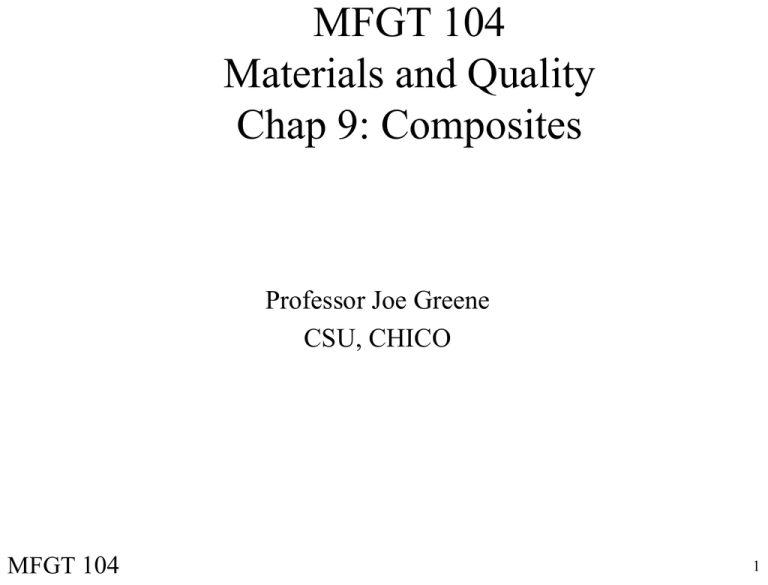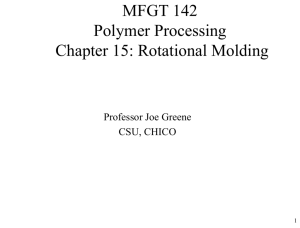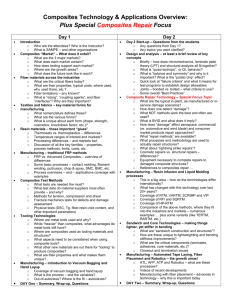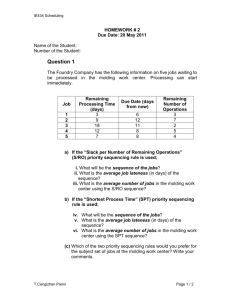History and Current Status of the Plastics Industry
advertisement

MFGT 104 Materials and Quality Chap 9: Composites Professor Joe Greene CSU, CHICO MFGT 104 1 Chap 9: Polymers Composites • Objectives – Define the components and difference types of composites. – Explain the different types of composite construction and the reasons behind them. – Describe the various manufacturing methods used to produce composites. – List the different reinforcing materials used in composites. – List the various matrix materials used in composites. • Excellent Web sites – Michigan State http://islnotes.cps.msu.edu/trp/ – U of Delaware http://www.ccm.udel.edu/publications/CU/99/ – Cornell University http://www.engr.siu.edu/staff2/abrate/NSFATE/links.htm 2 Composites • Composite definition – A composite is a material comprised of two or more physically distinct materials with at least one material providing reinforcing properties on strength and modulus. • Natural Composites – Bone – Wood – Bamboo: Natures fiber glass due to pronounced fibrillar structure which is very apparent when fractured. – Muscle and other tissue • Engineering Composites – Reinforced concrete beams – Thermoset composites: Thermoset resins (polyurethanes, polesters, epoxies) • Glass fibers, Carbon fibers, Synthetic fibers, metalfibers, or ceramic fibers – Thermoplastic composites (polypropylene, nylon, polyester,TPU,polyimide) • Glass fibers, Carbon fibers, Synthetic fibers, metalfibers, or ceramic fibers 3 SMC Sheet Molding Compound Automotive Applications of Plastics and Composites n Composite Intensive Vehicles RTM Resin Transfer Molding 8-25 -98 M41_au 25 4 Automotive Plastics and Composites Use • Exterior Composite Panels – doors • Sheet Molded Compound (SMC): Camaro, Firebird and Corvette • Resin Transfer Molding (RTM): Viper – hoods • Sheet Molded Compound (SMC): Camaro, Firebird, Corvette, Ford trucks • Resin Transfer Molding (RTM): Viper, Heavy duty trucks) – bumper beams • Glass Mat Thermoplastic (GMT): Camaro, Firebird, Venture, Transport, • Interior – floor pan • Resin Transfer Molding (RTM): Corvette • Engine – valve covers, intake manifolds, fluid containers, etc. 5 Automotive Plastics and Composites Use SMC Sheet Molding Compound SMC Sheet Molding Compound 6 Recreational Plastics and Composites Use • Snow Equipment – skis, snow boards, snow mobiles, etc. • Water Sports Equipment – water skis, water crafts, snorkel equipment, fishing gear – diving equipment • Land Sports Equipment – shoes, roller blades, skate boards, tennis, golf • Air Sports Equipment – plane kits 7 • Epoxy Applications for Thermosets – Protective coatings: maintenance coatings for industrial and marine, tank linings, industrial floorings, beer and beverage can coatings, food cans, appliance primers, hospital and laboratory furniture. – Bonding and adhesives: Automotive and aircraft industries adhesive to metals and composites. – Molding, casting and tooling: Molding compounds in electrical and electronic industries, casting resins, potting resins. Prototype and master model tools. – Laminating and composites: Binders in fiber reinforced laminates and composites. Laminates are used in printed wiring boards. Composite applications include filament winding (high performance pipes in oil fields, pressure vessels, tank and rocket motor housings), pultrusion, casting, and molding (graphite composites for aerospace applications) – Building and construction: Flooring (seamless, self-leveling, or epoxy terrazzo floors), repair of bridges and roads with glass and carbon fiber wraps, concrete crack repair, coat reinforcing bars, binders for 8 patios, swimming pool decks, and soil around oil-well drills. Applications for Thermosets • Polyester – – – – – Boat hulls, shower stalls, electrical components, appliances Recreation vehicles, automotive body panels, floor pans; SMC Soft tooling, patterns Cultured marble, buttons, corrosion resistant tanks and parts, Corrugated and flat paneling, simulated wood furniture, bowling balls, polymer concrete, and coatings • Polyurethane – Rigid foams: (MDI) Laminated board stock, Moldings, Bun, Foam in place insulation, sprayed foam, packaging – Semi-flexible foam: (MDI and TDI) Moldings, Integral-skin moldings – Flexible foam:(TDI) Moldings, integral skin molding, carpet underlay – Packaging: (TDI) Furniture cushioning – Microcellular foam: (MDI) RIM parts, shoe soles – Non-foam cast elastomers 9 – Coatings, binders, thermoplastic elastomers, sealants, paints Composite Classifications • Reinforcement Type – Discontinuous (fibers are chopped and dispersed in matrix resin) • Short fibers: fiber lengths 3mm or less (most injection molded materials) • Long fibers: fiber lengths greater than 6 mm. (Some injection molded materials with 6mm fibers, Sheet Molding Compound (SMC) with 1” fibers, DFP Directed Fiber Preforms for RTM and SRIM) • Particulates: fibers is forms as spheres, plates, ellipsoids (some injection molded materials reinforced with mineral fibers) – Continuous (fibers are throughout structure with no break points) • Glass roving: glass bundles are wound up in a packet similar to yarn. • Roving is woven into several weaves using a loom machine like in apparel. – Mat products: random swirl glass pattern. – Woven product: roving is woven into machine direction (warp) and cross direction (weft) – Uni product: roving is woven in one direction with a cross thread given to hold mat together. 10 Composite Classifications • Resin (or matrix) type – Thermoset resins- those that undergo a chemical cross-linking reaction • Epoxy: reaction of bisphenol A and epichlorohydrin • Polyester: reaction of difunctional acid (or anhydride) and a difunctional alcohol (glycol) • Polyurethane: reaction of alcohol and isocyanate • Phenolic • Silicone • Melamine – Thermoplastic resins- those that are formed under heat • • • • Polyamines (nylon) (short and long fibers) Polyesters (short and long fibers) Polypropylene (short, long fibers and continuous fibers) Other thermoplastic resins (short and long fibers) 11 Processing of Composites • Open Mold processes – – – – – Hand lay-up Spray-up Vacuum bag, pressure bag, autoclave Filament winding Centrifugal casting • Closed Mold Processes – Compression molding – Injection Molding [high pressure] – Resin Transfer Molding (RTM), Structural Reaction Injection Molding (SRIM) [low pressure] – Pultrusion 12 Properties of Materials • Tensile modulus – – – – – Low alloy steel Aluminum Carbon fiber Glass fiber Aramid fiber (Kevlar) 207GPa(30Mpsi) 72GPa (10Mpsi) 300GPa(40Mpsi) 76GPa (10Mpsi) 125GPa (20Mpsi) • Tensile strength – – – – – Low alloy steel Aluminum Carbon fiber Glass fiber Aramid fiber (Kevlar) 1500MPa(220Kpsi) 500MPa(75Kpsi) 2400MPa(360Kpsi) 2000MPa(300Kpsi) 3000MPa (450Kpsi) Density Spec Mod 7.85 g/cc 2.8 g/cc 1.8 g/cc 2.56g/cc 1.4g/cc 26spGPa 26spGPa 167spGPa 30spGPa 89spGPa Density Spec Str 7.85 g/cc 2.8 g/cc 1.8 g/cc 2.56g/cc 1.4g/cc 191spMPa 178spGPa 4320spGPa 781spGPa 2140spGPa 13 Thermosets • Thermosets are polymers that undergo a chemical reaction during the polymerization. • Thermosetting reaction is not reversible under heat. • Epoxy – Standard epoxy is based on bisphenol A and epichlorohydrin. – Properties include good adhesion to many substrates, low shrinkage, high electrical resistivity, good corrosion resistance, and thermal. – Processing is achieved without generation of volatiles. 14 • Polyester and Polyurethane Polyester – Thermoset reaction between a difunctional acid (or anhydride) and a difunctional alcohol (glycol) – Heat or radiation can trigger the cross linking reaction – Accelerators (or promoters) speed up the reaction. – Condensation Reaction results in CO2 and H2O. – Monomer required to polymerize, e.g., Styrene at 30% to 50% in commercial polyester systems • Polurethane – Reaction between isocyanate and alcohol (polyol). Condensation Reaction results in CO2 and H2O. – Crosslinking occurs between isocyanate groups (-NCO) and the polyol’s hydroxyl end-groups (-OH) – Thermoplastic PU (TPU) have some crosslinking, but purely by physical means. These bonds can be broken reversibly by raising the material’s temperature, as in molding or extrusion. 15 Polyurethane Chemistry • Reaction between isocyanate and alcohol (polyol). • Crosslinking occurs between isocyanate groups (-NCO) and the polyol’s hydroxyl end-groups (-OH) • Thermoplastic PU (TPU) have some crosslinking, but purely by physical means. These bonds can be broken reversibly by raising the material’s temperature, as in molding or extrusion. • Ratio between the two give a range of properties between a flexible foam (some crosslinking) to a rigid urethane (high degree of crosslinking). • In PUR foams density can range from 1 lb/ft3 to 70 lb/ft3. • Foams are produced by chemical blowing agents. 16 • Catalyst are used to initiate reaction. Processing of Composites • Open Mold processes – – – – – Hand lay-up Spray-up Vacuum bag, pressure bag, autoclave Filament winding Centrifugal casting • Closed Mold Processes – Compression molding – Injection Molding [high pressure] – Resin Transfer Molding (RTM), Structural Reaction Injection Molding (SRIM) [low pressure] – Pultrusion 17 Processing of Composites • Open Mold processes – Hand lay-up and Spray-up – Filament winding 18 Processing of Composites • Open Mold processes – Vacuum bag, pressure bag, SCRIMP – autoclave: Apply Vacuum Pressure and Heat in an oven which can be 5 feet to 300 feet long 19 Thermoset Reacting Polymers • Process Window – Temperature and pressure must be set to produce chemical reaction without excess flash (too low a viscosity), short shot (too high a viscosity), degradation (too much heat) 20 Processing of Composites • Closed Mold Processes – Compression molding [moderate pressure] – Injection Molding [high pressure] – Resin Transfer Molding (RTM), Structural Reaction Injection Molding (SRIM) [low pressure] – Pultrusion [low pressure] Injection Molding Annual Part 30K – 200K Production Volume Part Size Small < 2 lbs Compression Molding 30K – 200K Structural RIM 5K – 200 K Medium 2 lbs – 20 lbs Fixed Assets Tooling Cost Cycle Time $500K-$2M Medium Medium to large 5 lbs 2 lbs – 20 – 50 lbs lbs $300K-$1M $10K - $150K Materials $300K -$2M $50K -$500K $150K-$500K $50K$300K 1 sec – 30 sec – 30 sec – 30 sec 90 sec 120 sec Thermoplastic Thermoplastic Thermoset Thermoset Resin Transfer Molding 0.5K –5 K $20K - $300K 5 min – 30 min Thermoset 21 Injection Molding Glass Reinforced Composites • Plastic pellets with glass fibers are melted in screw, injected into a cold mold, and then ejected. Glass filled resin pellets 22 Composites Have a Fiber Preform • Fiber type – Roving form that can be sprayed into a 3-D preform – Roving form that is woven into a glass sheet and then formed to shape (preform) 23 Compression Molding • Compression molding was specifically developed for replacement of metal components with composite parts. The molding process can be carried out with either thermosets or thermoplastics. However, most applications today use thermoset polymers. In fact,compression molding is the most common method of processing thermosets. 24 Resin Transfer Molding • In the RTM process, dry (i.e.,unimpregnated ) reinforcement is pre-shaped and oriented into skeleton of the actual part known as the preform which is inserted into a matched die mold. • The heated mold is closed and the liquid resin is injected • The part is cured in mold. • The mold is opened and part is removed from mold. 25 Structural RIM • Fiber preform is placed into mold. • Polyol and Isocyanate liquids are injected into a closed mold and reacted to form a urethane. 26






